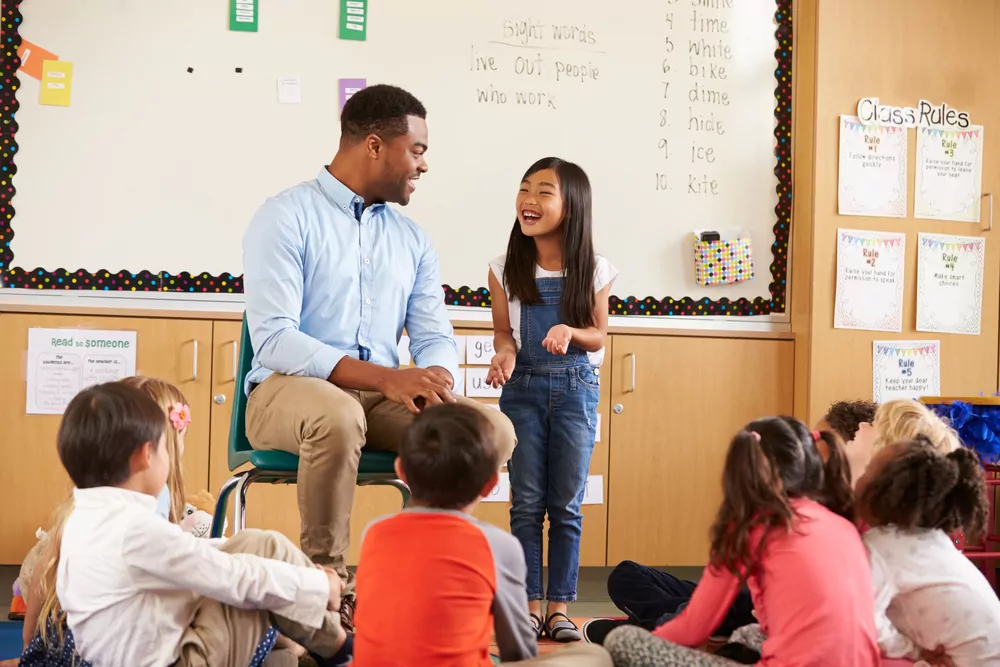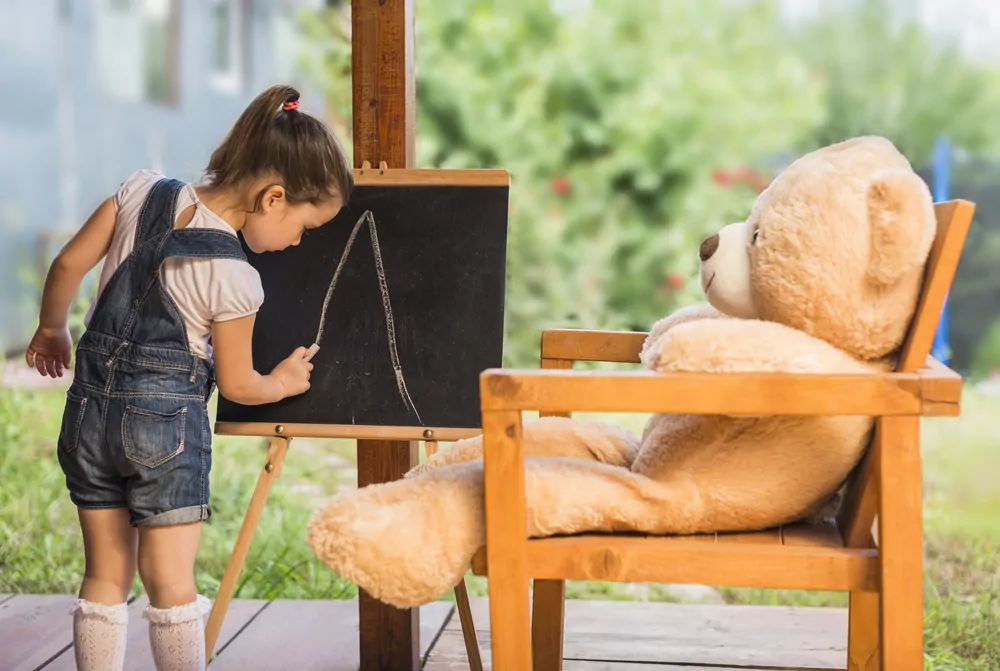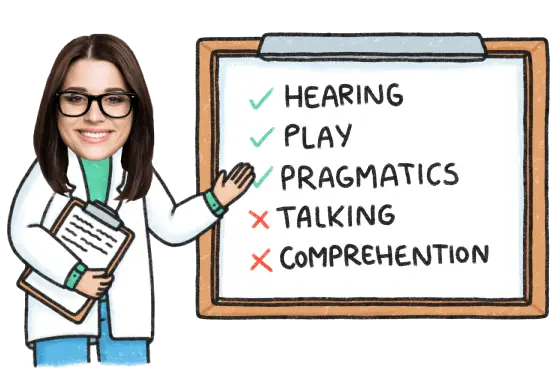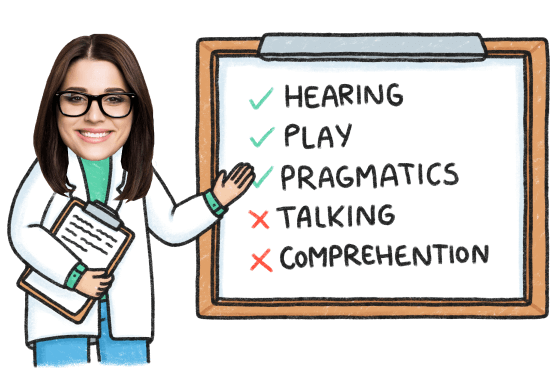Speech and Language Goals for Autistic Kids
Feb 12, 2022 There are several key developmental areas that speech therapists should be targeting when working with children who are on the autism spectrum.
When I’m at my private speech therapy practice, parents who have a child with autism always bring in their child’s IEP and have me look at the goals and objectives. This usually occurs when their child stops making progress and they are concerned that goals are unattainable or inappropriate for the needs of their kid.
IEP goals for autism
The goals can be broken down into categories:
- Joint attention
- Social reciprocity (give and take during conversational tasks)
- Language and related cognitive skills
- Behavioral and emotional regulation
Speech Blubs is helping kids on the spectrum! Check out Ash’s story, who started imitating animal sounds with the help of the Speech Blubs app.
After your IEP meeting, your report should list each goal with a measurable component to it. This means, that at the end of a marking period, trimester, or year, the child should be meeting certain characteristics of that goal.
For example, if the goal is to have your child sit during story time, a short-term goal might be that for 5 minutes of story time three times a week your child will sit and pay attention with moderate verbal or tactile (touch) cues. The long-term goal might be to have your child sit for 20 minutes of story time five times a week with minimal cues.
IEP Speech and Language Goals
These goals should also be broken up depending on age. A one-year-old is not going to be able to sit for 20 minutes of story time with minimal cues by the end of the school year.
However, a three-year-old should be able to do that goal successfully. Of course, other disabilities or cognitive issues will play a role in how fast your child meets any educational goal that is placed in his/her IEP.
1. Joint Attention
Joint attention is the shared focus of two or more individuals on an object, action, or event. It involves the ability to coordinate attention between oneself, another person, and an object or event in the environment. For example, when a child points to a toy and looks to their parent to share interest, or when two people look at each other while discussing a topic, they engage in joint attention. It is an important skill for social interaction, language development, and learning.

Your child’s IEP can include some or all of these goals:
- Responding to a caregiver’s voice.
- Shifting gaze between people and objects.
- Recognizing and describing emotional states of self and others.
- Commenting to share enjoyment and interests.
- Understanding what others are indicating with gaze and gestures.
- Using emotions of others to guide behavior in social interactions (e.g., selecting topics based on another’s preferences, praising others, sharing empathy).
2. Social Reciprocity
This is another way to say the give and take in a social interaction. We know how to respond to other people’s interests and responses. Children who are on the spectrum do not have that instinctual notion.

Here are some examples of goals that could be included in the social reciprocity section of an IEP:
- Maintaining interactions by taking turns.
- Initiating bids for interaction.
- Recognizing and attempting to repair breakdowns in communication.
- Engaging in topic maintenance (e.g., providing expansion comments).
- Initiating and maintaining conversations that are sensitive to the social context and the interests of others.
- Maintaining conversational exchanges with a balance between comments and requests for information.
3. Language and Related Cognitive Goals
Language and cognition goals are anything that has to do with the understanding and use of the child’s native language. This can also include nonverbal communication, such as gesturing.

Here are some examples of language and cognitive goals:
- Using a range of gestures to share intentions (e.g., giving, showing, waving, pointing),
- Pairing vocalizations with gestures to share intentions,
- Turning pages and pointing to pictures in books,
- Understanding and using more creative combinations of words,
- Understanding sequence of events in stories, attending to beginning and rhyming sounds, and naming alphabet letters,
- Enacting social sequences in a representational manner by incorporating themes or modifications introduced by others (e.g., role-playing and visualizing an event before it takes place),
- Demonstrating story grammar knowledge, decoding, and letter–sound correspondence and expanding literacy skills (e.g., reading comprehension and written expression),
- Problem-solving, self-monitoring, goal-directed behavior (i.e., executive functioning).
4. Behavioral and Emotional Regulation
This is one of the hardest areas for children who are on the spectrum to master because it’s the core of their diagnosis. This area relates to your child’s ability to understand his/her emotions, process them, communicate what they are feeling, and learn how to cope with the emotions they are experiencing.

Sample behavioral and emotional goals can include:
- Protesting undesired activities,
- Requesting a soothing activity when distressed,
- Expressing one’s emotional state and the emotional state of others,
- Using language to talk through transitions across activities,
- Perceiving one’s actions within social events and predicting social behavior in others in order to self-monitor,
- Negotiating and collaborating within interactions with peers.
Again, these are examples of goals that can be implemented in your child’s IEP. Make sure they are using goals that relate to your child’s areas of weaknesses and are attainable within a school term. Most of the goals that are suggested for this disorder need to be addressed in the home setting, as well. The more exposure they have to practice the goal, the quicker they will reach it.
Functional communication goals for autism
Functional communication is the way to break down barriers to a child’s independence. This means communicating wants and needs and when socializing with others. There are at least 50 functional communication goals to work on for kids of all ages and abilities, so make it a part of your daily conversation so that it doesn’t seem like lecturing or teaching. The IEP goals for autism in preschool should be specifically for your child and appropriately attainable.
Try and be as patient as possible and ask your therapist for a list of activities that you can address and target in the home environment. Finally, don’t shy away from activities in the community. This will be an integral part of your child addressing and sort of social deficit!
Have a question for our Speech Therapists?


how to teach where questions to special needs
Hi Naheed! Are you referring to “Wh” questions? It truly depends on the child, their communication disorder, and the severity of the disorder. Can you give us some more background on the child?
Stacie Bennett, M.S. CCC-SLP
Whats our long term goals for autism, language delay, Down’s syndrome
Hi Hala! All of these disorders will have different long-term goals; however, the main goal in any communication disorder is for the child to communicate with the least amount of support in the least restrictive environment. If a child cannot verbally communicate, our goal is to supply them with a communication device or equip them with another way to express their needs and wants (e.g. sign language). If these disorders have an accompanying behavioral component, we’d also want to create a system to decrease these.
Stacie Bennett, M.S. CCC-SLP
Hello,
Please suggest some therapy techniques for a 6 years old verbal autistic child for improving his general conversational skills. The child’s receptive skills are good, he does one to one conversation…answers to simple questions..but doesn’t do general talking and doesn’t express his feelings other than basic needs…He doesn’t express/ share any experience himself…
Pls do help.
Thanks for your support
General conversation skills are very difficult for children who are on the spectrum to learn. I work with high school students who are very high functioning and still require therapy to treat this skill. With that being said, your son should be enrolled in speech therapy, even as a verbal child. A speech pathologist will work on these conversational skills! Some suggestions would be:
1. Play games that allow your child to use his imagination and converse with others. An example of this type of game would be “What’s In Ned’s Head.”
2. Reading books related to feelings and emotions are another way for children who are on the spectrum to relate to what they are experiencing. For suggestions on this, please check out our blogs!
3. Keep asking questions. Even if he doesn’t answer, don’t give up!
Stacie Bennett, M.S. CCC-SLP
School SLP giving my ASD, HH child prompts of OBJECT (fruits) than asks WHO questions, my child gets confused, not learning WHO questions. He is very visual and comprehension is high, articulation is 3.3. He is 7yo
■ I asked SLP to provide a choice of 3 WHo instead. What other way? SLP offended at my suggestion.
Hi. I’m not sure I’m understanding your question correctly. If the speech pathologist is giving your child an object and asking them WHO questions, that does not make sense. They should be giving WHAT question prompts, instead. For example, “What fruit is round, red and has a stem?” If this is what you mean by your question, then you have every right to ask him/her a question regarding the therapy. Also, a therapist should always scaffold therapy. This means that if a child is understanding, we move them up to harder lessons and give less prompts. If they are not understanding, then we may need to decrease the difficulty of the task and give them some more verbal or visual cues. I hope that helps and if it doesn’t, please let me know and I’ll try and give you more suggestions!
Stacie Bennett, M.S. CCC-SLP
I am a Recreational Therapist and work with a child with global developmental delay. Non verbal. He hits himself in head quite frequently and mom states it is a communication issue. He has a lot of medical issues, uses a wheelchair and cannot eat anything. Can you suggest where I can start helping him with communicating his needs?
It does appear that his outbursts are due to frustration. I would work with mom to see what they are using as far as communication at home. Does he use sign language? One of the simplest tools to use is called a PECS board. It’s just a piece of paper (laminated) that has a bunch of pictures on it. The individual can point to what they need or want. I would start with that if there isn’t already another sort of communication device in use!
If you’d like to talk about it further, please write to ask-a-therapist@speechblubs.com. Thank you!